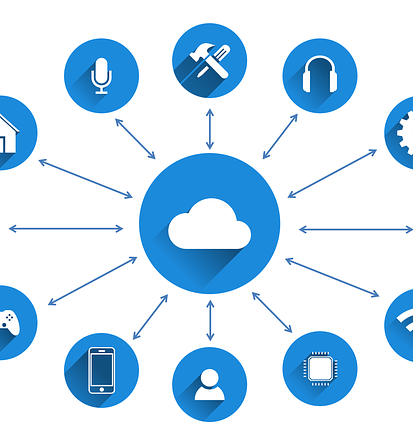“Things or IoT or Internet of Things” Internet is an interconnected computer system, mechanical or digital equipment, objects, animals, or people with a unique identifying (UIDs).
The Internet might also involve someone having a heart implant, a farm animal with a biochip transponder, a vehicle with embedded sensors to notify the driver about low-pump tires, or any other natural or man-made item that has an IP address and can transmit data through the network.
Importance Of IOT
If there is something connected to the Internet, information can be sent or received, or both. Sending and/or receiving information makes things clever and smarter.
Let’s make another example of smartphones. You may hear every song in the world, and not because every song has been stored on your phone. It’s because each song in the world is stored elsewhere (which is known as the “cloud”), and your phone can ask for a song to stream it.
To be intelligent, anything needs neither great storage nor a supercomputer. It’s all about connecting to a mega storage device or supercomputer. It’s terrific to be linked.
All things can be placed in three categories in the Internet of Things:
- Sensors that collect and then communicate information.
- Computers receiving and then acting on this information.
- Things both of them do.
And they all have huge advantages that feed on each other.
Technologies That Made IOT Possible
While the concept of IoT exists for a long time, it has been feasible by a compilation of recent developments in several technologies.
- Low cost, low power sensor technology access. IoT technology is made possible for more manufacturers by affordable and dependable sensors.
- Connectivity. A number of internet network protocols make connecting sensors with the cloud and other ‘things’ easier to send data efficiently.
- Platforms for cloud computing. The expansion in cloud platform availability enables both companies and consumers to obtain the infrastructure they need to expand without having to manage it all.
- Learning and analysis of machinery. Businesses are able to obtain insights more quickly and more simply with developments in machine learning and analytics, together with access to varied and extensive data in the cloud. The development of these linked technologies is further pushing the IoT limits and also feeding the data generated by IoT.
- Artificial intelligence (AI); conversational. Advances in neuronal networking made IoT equipment such as digital staff, Alexa, Cortana, and Siri attractive, affordable and viable for home use.
Industries Utilizing IOT
- Manufacturing
Production-line monitoring can provide a competitive edge to manufacturers to proactively maintain equipment if sensors identify impending failures. In fact, when industrial output is impaired, sensors can measure. The makers can immediately verify the precision or remove equipment from production until it is fixed with the use of sensor alerts. This enables businesses to lower operating costs, enhance operating times and improve asset management.
- Automobile
The automobile industry offers tremendous benefits through the adoption of IoT technologies. Automotive industry As well as the advantages of IoT applications for manufacturing lines, sensors can identify imminent equipment failure on-road vehicles and can inform the driver of specifics and recommendations. Thanks to the information collected through IoT apps, automakers and suppliers may understand how vehicle manufacturers and car owners can keep automobiles running and informed.
- Logistics and Transport
A range of IoT applications is available for transport and logistics systems. Automotive, truck, shipping, and inventory fleets can be replaced by IoT sensor data according to weather conditions, availability of vehicles, or driver accessibility. The stock could potentially be supplied with track and track sensors and temperature controls. The food and beverage industry, florist industry, and pharmaceutical industry commonly have temperature-sensitive inventories that would profit significantly from IoT monitoring applications that warn of rising and dropping temperatures to a risky degree.
- Retail
IoT applications enable retail businesses to manage merchandise, increase customer experience, improve supply chain and save operating expenses. Smart shelves with weight sensors, for example, can collect information on the basis of RFID and send data to the platform of IoT for automatic inventory monitoring and warning when things are low. Beacons can offer clients a lively experience by pushing customized offers and promotions.
- Sector Public
IoT’s benefits are similarly widespread in the public sector and in other service sectors. For example, IoT-based applications can be used by government utilities to warn their users of massive outages and even smaller water, power, or sewage interruptions. In order to assist utilities to recover more quickly from failures, IoT apps can collect data on the scope of an outage and use resources.
- Healthcare
The monitoring of IoT assets gives the health sector a number of advantages. The specific location of patient support facilities such as wheelchairs is often required for physicians, nurses, and caregivers. If a hospital has IoT sensors, the IoT monitoring application can track them so that anyone looking for a hospital can immediately identify the next nearest accessible wheelchair. The IoT asset monitoring application. This can track several hospital assets to guarantee that the physical assets in every department are used properly, as well as financially accountable.
- All Industries General Safety
IoT can be utilized to enhance worker safety in addition to the pursuit of physical goods. Employees in dangerous workplaces such as mines, oil and gas fields, and chemical plants and power stations, for instance, need to know about a dangerous incident. They can be notified or rescued as quickly as feasible when they are connected to the IoT sensor-based applications. Wearables that are capable of monitoring human health and environmental parameters are also employed for IoT applications. These types of applications not only assist consumers to understand their own health but also allow doctors to remotely monitor patients.
Security Concerns
Safety is one of the IoT’s major problems. In many circumstances, these sensors collect very sensitive data – for example, what you say and do at home. It is crucial to maintain this safety for consumer confidence, yet until the safety record of IoT has been exceedingly poor. Too many IoT devices have little regard for security principles such as data encryption in transit and at rest.
Software faults, including old and well-used code, are regularly found, but many IoT devices lack the capacity to be patched, which means that they are always under threat. Hackers are now actively targeting IoT equipment such as routers and webcams since they are made uncertain by the inherent lack of safety.
Flaws left smart household equipment accessible to hackers such as refrigerators, ovens, and dishwashers. Investigators have determined that there are 100,000 webcams that can easily be hacked, while some children’s smartwatches that are connected to the internet feature flaws that allow Hackers to follow where the wearer is, talk, or even speak with the wearer.
Governments here are increasingly concerned about the threats. It demands devices to have unique passwords, to give a public point of contact for anybody to report a vulnerability (and that this is done), and to specify exactly how long the device will receive security upgrades. It’s a small list, but it’s a beginning.
If the cost of creating smart items is insignificant, these difficulties grow more and more common and uncompromising.
All this also applies to companies, but it is more important. The linkage of IoT networks with industrial machinery increases the risk for hackers to discover and target such devices. The potential hazards are both industrial spying and a devastating attack on essential infrastructure. This means that companies need to ensure that these networks are segregated and secured with data encryption that requires the security of sensors, gateways and other components. However, the present state of IoT technology makes it more difficult to ensure, much as is the lack of uniform organizational IoT safety planning. This is highly troubling because hackers are recorded to handle industrial systems connected to the Internet but left unsecured.
The IoT bridges the gap between the digital world and the physical world, which can lead to catastrophic effects for the actual world. The operators could make a disastrous decision by hooked up to the temperature control sensors in a power station, and the operation of a driverless car could potentially result in a catastrophe.
Artificial Intelligence and IOT Data
IoT devices generate large volumes of data, information on the temperature of the engine or whether a door is open or closed or the read from an intelligent meter. All IoT data must be kept, gathered, and analyzed. One way firms make use of this data is to put it into artificial intelligence (AI) systems to use and anticipate the IoT data.
Google, for example, has placed an AI responsible for its cooling system for data centers. The AI analyses data drawn from hundreds of IoT sensors put into deep neural networks and predicted the effects of alternative options on energy use in the future. Google has made its data centers more efficient through the use of machinery and AI and stated that in other industrial settings the same technology might be used.
Cloud and Internet of Things

Because of the vast number of data IoT applications produce, many firms choose to process their data in the cloud instead of building up huge quantities of internal capacity. These companies are chasing cloud computing titans already: Amazon Web services provide a range of IoT services as does Google Cloud, Microsoft has an Azure IoT Suite.
IOT Development: what’s next with the Internet of Things?
As the price of sensors and communications continues to fall, adding additional IoT devices is cost-effective – but in some circumstances, the customer benefits are not very clear. Deployments occur early; most IoT companies are in the process right now, mainly because the essential technology – sensor technology, 5G, and machine-learning-powered analytics – is still in a fairly early stage of development. Many competing platforms and standards are available and many different suppliers – from device manufacturers, software businesses to network operators – want a piece of the pie. Which of these people won’t be obvious yet. However, in the next several years, we will probably see some more major IoT safety incidents without standards and security.
With the number of connected devices growing further, smart products are filled with our working and residential environments – provided that we accept the trade-offs between safety and privacy. Some people will welcome the coming era of intelligent things. Others pine for the days that a chair was just a chair.

